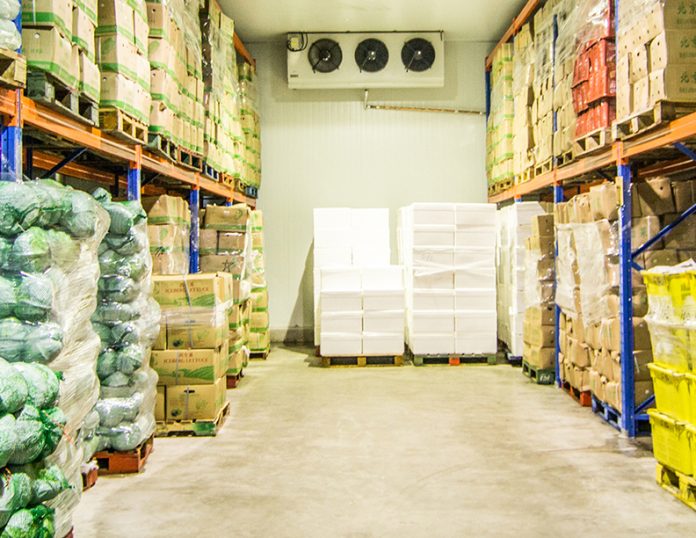
Cold storage is the one widely practiced method for bulk handling of the perishables between production and marketing processing. It is one of the methods of preserving perishable commodities in fresh and wholesome state for a longer period by controlling temperature and humidity within the storage system. Maintaining adequately low temperature is critical, as otherwise it will cause chilling injury to the produce. Also, relative humidity of the storeroom should be kept as high as 85-90 per cent for most of the perishables, below which has detrimental effect on keeping the quality of the produce.
Most fruits and vegetables have a very limited life after harvest if held at ambient harvesting temperatures. Post-harvest cooling rapidly removes field heat, allowing longer storage periods. Proper post-harvest cooling can:
- Reduce respiratory activity and degradation by enzymes;
- Reduce internal water loss and wilting;
- Slow or inhibit the growth of decay-producing microorganisms;
- Reduce the production of the natural ripening agent, ethylene.
In addition to help maintaining quality, post-harvest cooling also provides marketing flexibility by allowing the grower to sell produce at the most appropriate time. Having cooling and storage facilities makes it unnecessary to market the produce immediately after harvest. This can be an advantage to growers who supply restaurants and grocery stores or to small growers who want to assemble truckload lots for shipment. Post-harvest cooling is essential for delivering produce of the highest possible quality to the consumer. Cold storage can be combined with storage in an environment with addition of carbon dioxide, sulfur dioxide (in case of grapes) nitrogen, etc. according to the nature of product to be preserved. The cold storage of dried or dehydrated vegetables can be successfully carried out for a storage time of more than one year at 0°-10°C with a relative humidity of 80-95 per cent.
The cold storage of perishables has advanced noticeably in recent years, leading to better maintenance of organoleptic qualities, reduced spoilage, and longer shelf lives. These advances have resulted from joint action by physiologists to determine the requirements of fruit and vegetables, and by refrigerating specialists to design and run refrigerating machines accordingly.
Care should be taken to store only, those kinds, which does not show in compatibility of storage, when storing multi-produce in the same room. For example, apple can be stored with grapes, oranges, peaches, and plums and not with banana. However, with potato and cabbage slight danger of cross actions can occur. Contrary to this, grape in compatible to all other vegetables except cabbage. To resolve the incompatibility during cold storage, foodstuffs are grouped into three temperature ranges
Based on their thermal incompatibility the produce is classified into:
Most perishable products, not sensitive to cold (0-4°C)
e.g. Apple, grape, carrot and onion
Vegetable produce moderately sensitive to cold (4-8°C)
e.g. Mango, orange, potato and tomato (ripened)
Vegetable produce sensitive to cold (>8°C)
e.g. Pineapple, banana, pumpkin and lady finger
Based on the purpose, the present day cold stores are classified into following groups:
Bulk cold stores: Generally, for storage of a single commodity which mostly operates on a seasonal basis e.g.: stores for potatoes, chilies, apples etc.
Multi-purpose cold stores: It is designed for storage of variety of commodities, which operate practically, throughout the year.
Small cold stores: It is designed with pre-cooling facilities. For fresh fruits and vegetables, mainly for export-oriented items like grapes etc.
Frozen food stores: It is designed for with (or) without processing and freezing facilities for fish, meat, poultry, dairy products and processed fruits and vegetables.
Mini units or walk in cold stores: It is located at distribution center etc.
Controlled atmosphere (CA) stores: It is mainly designed for certain fruits and vegetables
General Arrangements and Consideration
If produce is to be stored, it is important to begin with a high quality product. The produce must not contain damaged or diseased units, and containers must be well ventilated and strong enough to withstand stacking. In general, proper storage practices include temperature control, relative humidity control, air circulation and maintenance of space between containers for adequate ventilation and avoiding incompatible product mixes. Commodities stored together should be capable of tolerating the same temperature, relative humidity and level of ethylene in the storage environment. High ethylene producers (such as ripe bananas and apples) can stimulate physiological changes in ethylene sensitive commodities (such as lettuce, cucumbers, carrots, potatoes, sweet potatoes) leading to often undesirable color, flavour and texture changes.
The general features of a cold store operational programme (products, chilling and chilled storage and freezing) include total capacity, number and size of rooms, refrigeration system, storage and handling equipment and access facilities. The relative positioning of the different parts will condition the refrigeration system chosen. The site of the cold chambers should be decided once the sizes are known, but as a general rule they should be in the shade of direct sunlight. The land area must be large enough for the store, its annexes and areas for traffic, parking and possible future enlargement. A land area about six to ten times the area of the covered surface will suffice.
There is a general trend to construct single-storey cold stores, in spite of the relatively high surface: volume ratio influencing heat losses. The single storey has many advantages: lighter construction; span and pillar height can be increased; building on lower resistance soils is possible; internal mechanical transport is easier. Mechanical handling with forklift trucks allows the building of stores of great height, reducing the costs of construction for a given total volume.
The greater the height of the chambers the better, limited only by the mechanical means of stacking and by the mechanical resistance either of the packaging material or of the unpackaged merchandise. The length and width of the chambers are determined by the total amount of merchandise to be handled, how it is handled (rails, forklift trucks), the number of chambers and the dimensions of basic handling elements. There is no advantage in building many chambers of a small size. Thermal and hygrometric requirements are not so strict as to justify a lot of rooms: the accuracy of the measuring instruments and the regulation of conditions inside the chamber always produce higher deviations than those of ideal storage conditions for different products. This is particularly true for frozen products.
A design that opts for fewer, larger chambers represents in the first place an economy in construction costs as many divisional walls and doors are eliminated. Refrigeration and control equipment is simplified and reduced, affecting investment and running costs. Large chambers allow easier control of temperature and relative humidity and also better use of storage space. Only in very particular situations should the cold store be designed with more than five or six cold chambers. Store capacity is the total amount of produce to be stored. If the total volume of the chambers is filled, the quantity of produce by unit of volume will express storage density.
Several parameters must be defined within a cold store. The total volume is the space comprised within the floor, roof and walls of the building. The gross volume is the total volume in which produce can be stored, that is excluding other spaces not for storage. The net volume represents the space where produce is stacked, excluding those spaces occupied by pillars, coolers, ducts, air circulation and traffic passages inside the chambers that are included in the gross volume. Storage density referred to as net volume is expressed in kg/m3. But it is most commonly referred to as gross volume. About 3.4 m3 of volume is required per ton of potato to be preserved while for onions this value is about 5.7 m3/t. Thus, one can calculate the total volume of storage space as soon as the amount of storage product is known. An index of how reasonably and economically the cold store has been designed is the gross volume divided by the total volume. It must be in the range of 0.50 to 0.80. Similarly, gross volume is about 50 per cent greater than net volume, and gross area (same concept as volume) is about 25 per cent greater than net area. The extent of occupation is the ratio between the actual quantity of produce in storage at a given moment and that which can be stored. Equally the extent of utilisation is the average of the extent of occupation during a given period — usually a year, but it can also be per month.
The earlier cold storage were cubical in shape in order to minimize the surface area for a given
volume, i.e., a = b = H = V1/3
Where a, b, H and V are width, breadth, height and volume of storage space. In doing so the height of large cold storage becomes too big, causing material handling, stacking and similar other problems. A comparative study of the single and multi-storeyed cold store buildings has been made with respect to space and installation (Heinze, 1973). It has been found that the single-storeyed buildings turn out to be a better choice. However, the multi-storeyed cold storages with mechanised arrangements are preferred for the multi-variety systems, especially, in cities where the floor area is extremely expensive. Sometimes cold storage size is based on floor area, i.e., about 100 kg m2. However, there does not exist a unique specification agreed upon and used internationally. Despite lots of discussions differences on specification on the cold storages exist.
Temperature management during storage can be aided by constructing square rather than rectangular buildings. Rectangular buildings have more wall area per square meter of storage space, so more heat is conducted across the walls, making them more expensive to cool. Temperature management can also be aided by shading buildings, painting storehouses white or silver to help reflect the sun’s rays, or by using sprinkler systems on the roof of a building for evaporative cooling. Facilities located at higher altitudes can be effective, since air temperature decreases as altitude increases. Increased altitude therefore can make evaporative cooling, night cooling and radiant cooling more feasible. The air composition in the storage environment can be manipulated by increasing or decreasing the rate of ventilation (introduction of fresh air) or by using gas absorbers such as potassium permanganate or activated charcoal. Large-scale controlled or modified atmosphere storage requires complex technology and management skills; however, some simple methods are available for handling small volumes of produce.
Heat Load Calculations
The optimal storage temperature must be continuously maintained to obtain the full benefit of cold storage. To make sure the storage room can be kept at the desired temperature, calculation of the required refrigeration capacity should be done using the most severe conditions expected during operation. These conditions include the mean maximum outside temperature, the maximum amount of produce cooled each day, and the maximum temperature of the produce to be cooled. The total amount of heat that the refrigeration system must remove from the cooling room is called the heat load. If the refrigeration system can be thought of as a heat pump, the refrigerated room can be thought of as a boat leaking in several places with an occasional wave splashing over the side. The leaks and splashes of heat entering a cooling room come from several sources:
- Heat Conduction – Heat entering through the insulated walls, ceiling, and floor;
- Field Heat – Heat extracted from the produce as it cools to the storage temperature;
- Heat of Respiration – Heat generated by the produce as a natural by-product of its respiration;
- Service Load – Heat from lights, equipment, people, and warm, moist air entering through cracks or through the door when opened.
Fundamentals for Designing a Cold Storage Project
The design of cold storage facilities is usually directed to provide for the storage of perishable commodities at selected temperature with consideration being given to a proper balance between initial, operating, maintenance, and depreciation costs. The basic procedures for constructing (or) implementing the cold store units have the following requirements:
Process Layout
The most important requirement for any food project using insulated envelopes is to determine the process layout of the operation which is to be housed by the envelope. In the case of a meat plant, this can be a carcass dressing line or a boning room, or for a cold store, the pallet layout and mode of operation must be established. It is simply no good building an envelope and then attempting to place the processing machinery inside it.
Planning Drawings and Application
It is only after concluding the process layout that a planning application can be made when the dimensions of the envelope and supporting buildings can be frozen.
Design Drawings and Specifications
Once planning approval has been obtained then the preparation of design drawings and specifications can proceed. For a competitive design and construct tender, it is essential to prepare some 15 – 20 detailed drawings covering, at the minimum, the process layout, elevations and sections, the refrigeration system layout, mechanical and electrical systems reticulation and the lighting layout.
In addition to make up package at least six separate detailed specifications are required covering the project’s requirements on:
- Contractual requirements
- Building specification
- Refrigeration specification
- Insulation panel supply and erection
- Electrical requirements
- Mechanical services.
The location chosen for the cooling facility should reflect its primary function. If the plan is to conduct retail sales of fresh produce from the facility, it should be located with easy access to public roads. A retail sales operation located away from the road, particularly behind dwellings or other buildings, discourages many customers. Adequate parking for customers and employees, if any, must be provided.
If, however, the primary function of the cooling facility is to cool and assemble wholesale lots, ease of public access is less important. In this case, the best location may be adjacent to the packing or grading room. In addition to housing grading and packing equipment, the space could be used to store empty containers and other equipment and supplies when it is not needed for cooling. All cooling and packing facilities should have convenient access to fields or orchards to reduce the time from harvest to the start of cooling.
Regardless of how it is used, the facility will need access to electrical power and water. For larger cooling rooms requiring more than about 10 tons of refrigeration in a single unit, access to three-phase power will be necessary. The location of existing utility lines should be carefully considered, as connection costs can be prohibitive in some rural areas. Consult local power company for details.
In addition, it is a good idea to anticipate any future growth when locating and designing your facility. The cold storage unit should be built on a site, a where the ground in clean, well drained and preferably leveled and near to supplies of energy and water. If possible, it should be in the shade of prevailing wind and direct sunlight. A refrigerated store, with one (or) more thermally insulated places, and refrigerating machines can be planned with the aim of assuring certain services. The details about :
- Nature of the products
- Frequency of loading and unloading
- Calendar for harvest and dispatch
- Field heat of the produce
- Daily tonnage of produce to be handled
- Daily tonnage of ice to be manufactured
- Nature and dimension of packages
The above particulars are to be collected before initiating the cold storage unit work. The conditions to be considered for planning, a cold storage are temperature and duration of storage, handling and stacking method, type of; commodities to be stored together, prevailing climatic factors like temperature, relative humidity, rainfall, wind and water. Availability of skilled and unskilled labor from the local area is the major factor to be considered for the successful operation.










Chennai
We want to make an enquiry about prescribed temperature for vegetables and fruits can you provide us a pdf file.
We want to set up a plant for fresh ripen fruits. How can you help me?
I would like to set up 3 cold room for fruit and veg approximately 30 ton capacity each room for export purpose
Appliance Maintenance Repair Chicago offers affordable, same-day solutions for residential and commercial appliances. Our expert technicians provide emergency repairs, troubleshooting, and installation across Chicago and surrounding areas, including Naperville and Schaumburg, ensuring your appliances are well-maintained and functional.
If your wolf microwave oven is not heating your food, you can consider the Subzerorepair247.com care will help you figure out the cause of the problem and how to solve it
Our web designers in San Fransisco can help you create professional and affordable website design and Web Design strategies with measurable commercial advantage